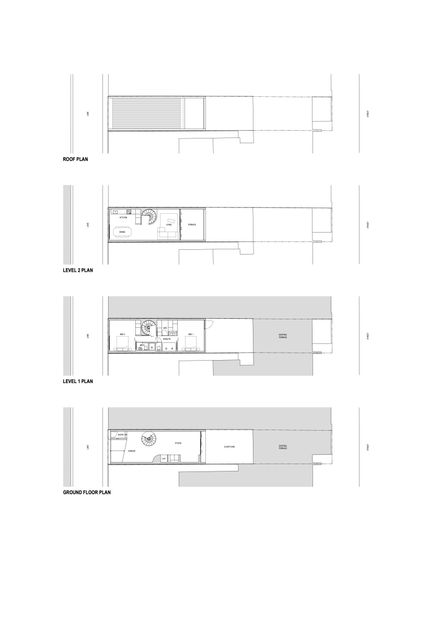
Laneway Glass House
ARCHITECTS
Brad Swartz Architect, Henry Wilson
LEAD ARCHITECTS
Brad Swartz, Mark Hill, Adele Issac, Henry Wilson
PHOTOGRAPHS
Tom Ferguson, Katherine Lu
AREA
141 M²
YEAR
2021
LOCATION
Darlinghurst, Australia
CATEGORY
Houses
On the Sydney city fringe, a tiny laneway tower, inspired by a French classic, embodies an ethos of simplicity, utility, and beauty.
It came from a 5-year collaboration between award-winning practice Brad Swartz Architects, and globally branded industrial designer Henry Wilson.
On a compact 56 square-meter footprint, the infill building behind a Victorian terrace replaces a double tandem car space just 4.7 meters wide.
Its Palladian floor plan flips the usual terrace/townhouse model, locating the studio at ground level, bedrooms and bathrooms above, and living area, kitchen, and outdoor terrace on the top level, maximizing light, privacy, and views.
Rooms are separate but interconnected, each enjoying a view of something beyond. The efficient interior floor plan has only four square meters of dedicated circulation space, courtesy of a spiral staircase (in concrete and steel) and a walk-through ensuite to the main bedroom.
Fortifying the entire western (laneway) elevation is a stunning glass-block wall that anchors the building and softly diffuses light throughout all three levels.
Off the main living area is a sun terrace that takes in an eclectic neighborhood view. “What the building lacks in width, it more than makes up for in spatial volume and quality of light,” says architect Brad Swartz.
His practice is renowned for unlocking the hidden potential of even the tightest of sites.
“The spiral stair unlocked the ensuite but meant that at every point in the whole house, you can see the full interior width (4.7m meter).
“The spiral stair unlocked the ensuite but meant that at every point in the whole house, you can see the full interior width (4.7m meter).
Each level has well above regulation-height ceilings, which gives a sense of grandeur you’d expect to see in larger old terrace houses.” Brad Swartz, architect.
Swartz says the result is a blueprint for urban density done well in the city-fringe suburbs, through its reuse of an existing infill site to add housing.
Apart from judicious use of the site planning regulations (not maxing out the permissible floor area), the trick, says Swartz, is to “scrutinize every aspect of the plan, construction methods, and materials, taking nothing for granted.”
Wilson asked that the house express his pared-back design aesthetic and his elemental palette of materials.
In close collaboration, Swartz and Wilson found ways of using cost-effective materials in unique ways to elevate the finishes.
The ground floor’s structural concrete floor slab is burnished for a beautiful and durable finish. In the home above, standard travertine tiles are laid without grout lines to lend the effect of luxurious larger slabs.
For the glass wall, standard glass blocks (sandblasted on the inside face) were chosen over cost-prohibitive bespoke versions.






















